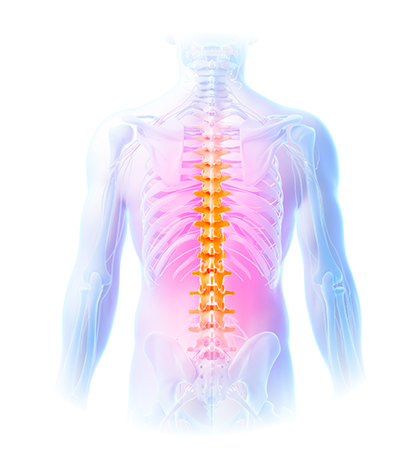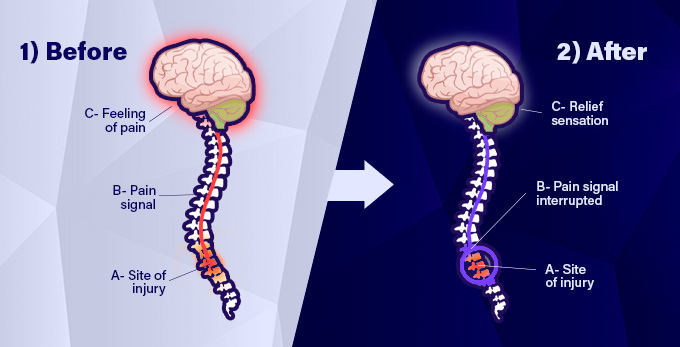Treating Back Pain and Leg Pain with Neurostimulation
Neurostimulation, also called spinal cord stimulation, provides drug free pain relief through the use of a small electronic device which is controlled by you, the patient. Neurostimulation is a well studied therapy that has been used for over four decades in treating pain that is resistant to more conventional treatments. Electrical impulses emitted by the device disrupt pain signals traveling along the spinal cord to the brain. With traditional neurostimulation, patients could feel the electrical impulses as a faint tingling sensation, however with newer technology electrical impulses can be delivered that are imperceptible to you and still block pain signals.
What is Neurostimulation?
Neurostimulation is a pain relieving technology designed for people with chronic back pain, neck, arm pain or leg pain; it can also sometimes be used to treat persistent knee, abdominal, or shoulder pain. It is one of the most effective treatments for patients with “failed back surgery syndrome” who still have back pain or leg pain after spine surgery. It is generally reserved for patients who have not responded to traditional treatment methods for pain, such as physical therapy and medications. Neurostimulation works by disrupting pain signals which travel from painful areas of the body through the spinal cord to the brain, where these signals are processed as pain sensations.

Small wires, called leads, are placed near the spine in the epidural space and gentle pulses of painless electricity help disrupt the incoming pain signals from your body. The leads are powered by a small battery.
The neurostimulator device comes with a handheld programming device which allows you to change the intensity and position of the stimulation (with a doctor’s guidance) to match the intensity and position of your pain. You may experience increased pain at specific times of the day or when engaging in certain physical activities. At these times you can use the handheld programmer to adjust the stimulation so that it optimally covers the area where pain is most severe. Using the handheld device, you can control whether or not you feel the electrical stimulation. This technology allows you to have independence and active control over your own therapy, without having to consult a healthcare professional everytime a small adjustment needs to be made.
How effective is Neurostimulation?
Neurostimulation works by disrupting pain signals as they travel through the spinal cord to the brain. Neurostimulation is a well studied, sophisticated technology that can effectively treat pain, even in those patients who have not responded well to other therapies, such as physical therapy, medications, injections, and surgery. Effective pain control enables patients to engage in physical activities and resume an active lifestyle. If the location or severity of the pain changes, the stimulation can be adjusted in a simple and non-invasive way.
Did you know?
All of our back pain treatment specialists in New York and Clifton, West Orange & Paramus NJ are Board Certified in Pain Management and Harvard Trained.
with an experienced Board Certified Back Pain Treatment Doctor.
What to Expect

Here is what to expect from Neurostimulation Procedures for Back Pain
Back Pain Relief through Neurostimulation
There are two phases of the neurostimulation procedure: first the minimally invasive trial phase and then the implant phase. The trial phase allows you to try out the neurostimulation technology to see if it works for you, usually for 7 days. If it provides effective pain relief, you can proceed to the implant phase.
Why is there a trial?
A trial period using a temporary neurostimulation system is generally performed before the neurostimulator is permanently placed. A trial will help you and your pain specialist determine whether or not neurostimulation is a good option for you and whether you should have the neurostimulation device placed for long term use.
Phase I: Trial Phase
The Trial Procedure
- The neurostimulation trial is a minimally invasive procedure usually performed in a specialized procedure suite in your physician’s office or at an outpatient surgical center. The procedure is usually performed under local anesthesia or with light sedation to keep you comfortable.
- There are no incisions during the trial phase and there is minimal recovery time.
- First, the skin over the procedure site is thoroughly cleaned with a sterilizing solution, such as chlorhexidine, and sterile drapes are placed to keep the procedure area sterile and minimize the risk of infection.
- The spine is visualized using a specialized type of x-ray, called fluoroscopy. Performing the procedure with fluoroscopic guidance improves the safety of the procedure and decreases disruption of surrounding tissues.
- The skin and deeper tissues are thoroughly anesthetized using a local anesthetic like lidocaine to minimize any discomfort during the procedure.
- A needle is used to access a specific area of the spine, the epidural space. The needle is slowly advanced and the appropriate needle placement is confirmed using fluoroscopy.
- Once the target area is reached, thin insulated wires, called temporary leads, are positioned in the epidural space of your spine and will deliver electrical impulses to block your pain.
- With some types of devices, your physician may test the device during the procedure to make sure the area of stimulation corresponds to the area where you are having pain.
- After the procedure, the temporary leads are connected to a small battery, which is external and worn around the waist. During this phase of the procedure the battery is on the outside of the body, not permanently placed.
The Trial
- After the procedure your doctor will be able to adjust stimulation levels using a handheld, wireless programmer and check your response. You will also learn how to control the handheld programmer so that you can adjust the stimulation independently and try out different programs during the trial, which typically lasts 7 days.
- During the trial it is recommended that patients refrain from strenuous physical activity and avoid bending and lifting heavy objects. Your doctor will also discuss special precautions to take when bathing.
- At the end of the trial, regardless of whether or not you experienced good pain relief, the temporary leads will be removed. This is a simple procedure usually performed in your doctor’s office. The trial may last approximately 7 days, during which time you can go about your usual daily activities and assess your level of pain control with the device.
At the end of the trial, you and your doctor will have a discussion to decide if you want to proceed with placement of the permanent device. If you do decide to go for it, here is what to expect during the second step.
Phase II: Permanent Placement Phase
Steps
- The neurostimulation implant is a minor surgical procedure that does not alter your spinal anatomy and will be performed in a hospital or ambulatory surgical center. This is an outpatient procedure and you can go home the same day.
- Anesthesia for the procedure usually involves local anesthesia and deep sedation to keep you comfortable.
- As in the trial phase, the skin is prepped in a sterile fashion, local anesthetic is administered, and the neurostimulation leads are placed in the epidural space under x-ray guidance. Two small incisions (2 to 3 inches long) are made next to the spine and the neurostimulation leads are secured in the epidural space so they do not shift position.
- With some types of devices, your physician may test the device during the procedure to make sure the area of stimulation corresponds to the area where you are having pain.
- A second incision is then made to create a pocket under the skin to implant the neurostimulator battery. This incision is usually made in an inconspicuous area, such as the buttocks.
- The neurostimulator leads are then tunnelled under the skin and connected to the battery.
- The incisions are closed layer by layer and then sterile bandages are applied.
- In the recovery room your doctor and a representative from the device company will review proper use of the neurostimulator handheld device, which you learned to use during the trial. Patients generally go home the same day of the procedure.
Board Certified
Harvard Trained

What are the Pros and Cons of Neurostimulation?
Pros of lumbar Neurostimulation for back pain:
- Provides effective pain relief – even if you have not responded well to surgery or other pain treatments.
- Is drug free – many patients are able to decrease or entirely stop their pain medications with this therapy. This is especially beneficial for patients who experience side effects with oral medications and those who cannot tolerate medications (like steroids) that are often used in pain injections.
- Provides long-lasting relief – unlike traditional pain injections which may need to be repeated several times per year, neurostimulation can provide pain relief that lasts for years or even a lifetime with minimal adjustments and doctor visits. This may be particularly valuable for patients taking medications like blood thinners who would have to stop these medications for pain procedures.
- Unique trial period – gives you a chance to experience the treatment before deciding whether or not to have the permanent device.
- Leads to improved mobility – enhancing your ability to perform daily activities and improving your quality of life.
- Independent control over your pain – the wireless programmer provides you with immediate control over the neurostimulator and the ability to change your settings as needed, such as when doing different physical activities.
- Neurostimulator support – a personal device representative is available to answer questions or concerns you may have about your neurostimulator even after it is implanted.
- Reversible treatment – the device can be surgically removed without any impact on your spinal anatomy.
- Traditional pain treatments can still be performed – if you develop pain in a different area of the body, conventional pain treatments (such as injections) can still be performed.
Cons of lumbar Neurostimulation for back pain
- As with any procedure or surgery involving the back, there is a small risk of bleeding, infection, or nerve damage. These risks are minimized as the procedure is performed using a sterile technique and under x-ray guidance.
- After the permanent device placement you may have some post-surgical pain for a few days; this is generally managed with rest, ice, and pain medication. This procedure also requires small incisions that may leave small scars, although these generally fade with time.
- The amount of relief achieved after the permanent implant may be slightly higher or lower than the relief that was achieved during the trial phase.
- It is possible that the therapy may become less effective over time; this can be due to a variety of reasons such as movement of the leads or worsening of your underlying condition.
- Depending on the specific device that is implanted, there may be some restrictions regarding the types of MRI you can have.
- Speak to your doctor about the type of battery that is best for you – some devices need to be charged on a regular basis whereas others need to have the battery replaced every 10 years.
It is recommended that you talk directly to your doctor for a detailed understanding of the pros and cons of this treatment for you.
Am I a candidate for Back Pain Treatment through Neurostimulation?
The suitability of this treatment for you depends on the type and severity of your pain, and how you respond to other pain treatments. Your doctor may recommend it to you if:
- Other treatment options have failed to provide adequate pain relief
- You are advised against major surgeries to treat the problem
- You do not have dependence on pain medication that could interfere with the effectiveness of the therapy
- You do not have medical issues that will make a minor procedure risky.
- You have a successful trial period indicating this treatment is suitable for you
- Failed Back Surgery Syndrome (FBSS)
- Sciatica
- Radicular pain syndrome
- Postlaminectomy pain syndrome
- Multiple back or spine operations
- Unsuccessful disk surgery
- Degenerative Disk Disease (DDD)
- Peripheral neuropathy
- Epidural fibrosis
- Arachnoiditis or lumbar adhesive arachnoiditis
- Ischemic limb pain
- Phantom limb pain
- Complex Regional Pain Syndrome (CRPS), Reflex Sympathetic Dystrophy (RSD), or causalgia
Experiencing Pain?
Side Effects of Neurostimulation Treatment
Because the neurostimulation device avoids medication and uses electrical impulses to block pain signals, there are generally few side effects once the device is permanently placed. With older technology, the most common side effect was a faint tingling sensation from the electrical impulses, which some patients found uncomfortable. However, with newer technology electrical impulses can be delivered that are not noticeable to the patient and still block the transmission of pain signals. Now, patients have the option to choose whether or not to feel the tingling sensation.
Other side effects include the possibility of electromagnetic interference between the neurostimulation device and electrical equipment used in other unrelated surgical procedures. This is usually managed by turning the neurostimulation device off if you require surgery in other parts of your body. There may be limitations or precautions that need to be taken if you require an MRI.
Neurostimulation FAQ
What should I do to prepare for my treatment?
In preparation for your neurostimulation trial or permanent device, your physician will explain what to expect and may provide you with information about the procedure. Your physician will determine if you have any medical conditions, such as diabetes or chronic infections, that need to be optimized prior to the procedure. Your physician will also discuss any medications, such as blood thinners, that may need to be temporarily held before the procedure. You will also have an opportunity to direct questions to a representative of the device manufacturer. A psychological evaluation may also be done to determine if the treatment will be suitable for you.
What should I do after my treatment?
You can enjoy an active life after the implantation of the neurostimulator, but there are certain precautions to keep in mind. You should inform your other healthcare providers that you have a neurostimulation device. Depending on the specific device, there may be restrictions on the types of MRI you can have. Additionally, the device may need to be temporarily powered off before going through other medical procedures that use electrical equipment, as this may cause electromagnetic interference.
It is important to understand how to properly charge and adjust the neurostimulator device using the wireless programmer. Your doctor and the device representative will explain the different features to you.
Yourdoctor may advise you to avoid activities that put undue stress on the implanted device, such as extreme flexion or extension of your back. Patients are advised not to scuba dive below 10 meters of water or enter hyperbaric chambers above 2.0 atmosphere absolute.
Does this treatment option hurt?
The trial phase is performed under local anesthesia, usually with some sedation for your comfort. The procedure area is thoroughly anesthetized with local anesthesia so there is minimal discomfort. After the procedure patients can have some soreness at the procedure site; this is usually managed with non-prescription pain medications and resolves in a day or two.
The permanent device placement is performed under deep sedation with local anesthesia. IV pain medication is often given at the time of the procedure. After the procedure you may initially feel some discomfort at the surgical site. Generally, this post-procedure pain only lasts a few days and is managed with rest, ice, and pain medication for 2-3 days.
Can this treatment be treated if my pain returns?
The neurostimulator device is designed to provide long-lasting pain relief and is only placed in the body after a successful trial. Generally, once the device is implanted, you will continue to have good relief and only make minor programming adjustments using the wireless programmer. If the device stops working for you or if your pain resolves and the device is no longer needed, it can be removed. If you develop pain in a different part of your body not covered by the neurostimulator, an additional device can be implanted. If the device is removed from your body and you want to have a new device implanted later on, this may be possible and you should discuss this with your physician. Patients who have had a neurostimulator device for many years may be able to upgrade their device as newer, more sophisticated technology becomes available.
How long does this treatment take?
The first part of the neurostimulation procedure, the trial phase, generally lasts for 7 days. The trial phase is followed by a short waiting period so that the previous insertion sites for the leads can heal. This will also give you an opportunity to discuss your response to the trial phase with your physician and decide if you want to proceed with the permanent placement. The implant procedure is a minimally invasive procedure that is performed in a hospital or ambulatory surgical center. Generally patients are able to go home the same day of the procedure. There is a short recovery period after which patients are able to return to their usual daily activities.
pain treatments
Book Now
Expect a call from our Pain Treatment Center scheduling team. We will collect your insurance information to ensure you’re covered and book you an appointment as soon as possible.
Give us a call at (855) 383-7054
Experience pain relief asap
Dr. Laura Lombardi
Pain Doctor New Jersey
Harvard Medical School
Dr. George Hanna
Pain Doctor New York
Harvard Medical School
Dr. Michael Nguyen
Pain Doctor
Harvard Medical School
Dr. Shane Volney
Pain Doctor New York
Harvard Medical School
Dr. Jeffrey Deygoo
Pain Doctor New York & New Jersey
Hofstra-Northwell School of Medicine
Dr. Jack Bulat
Harvard Medical School






